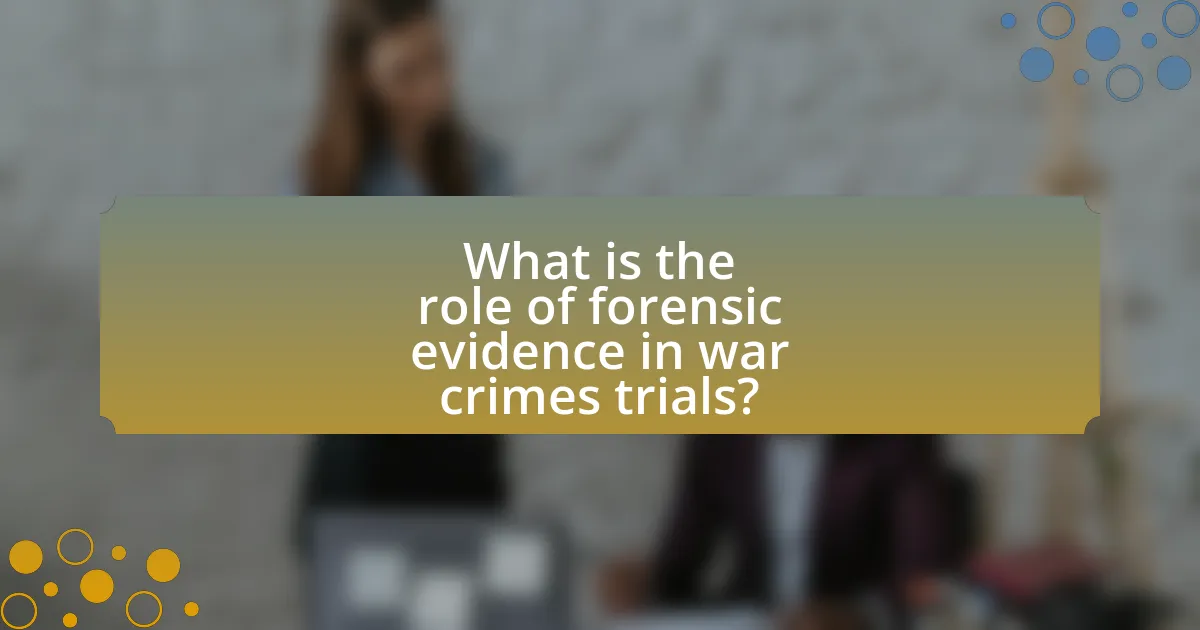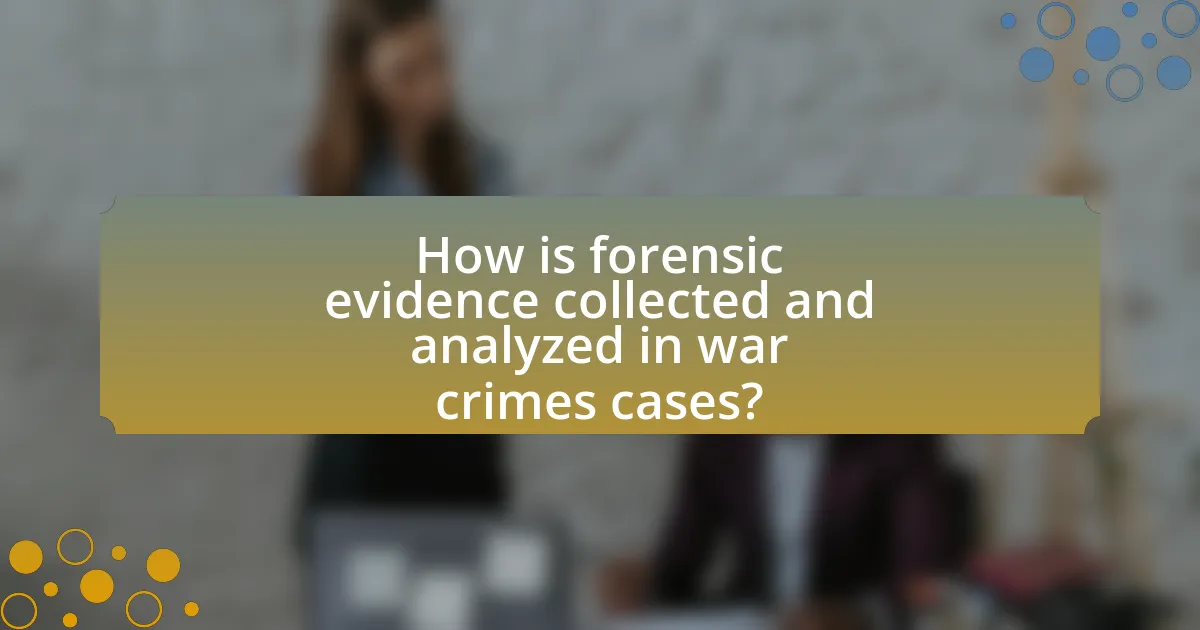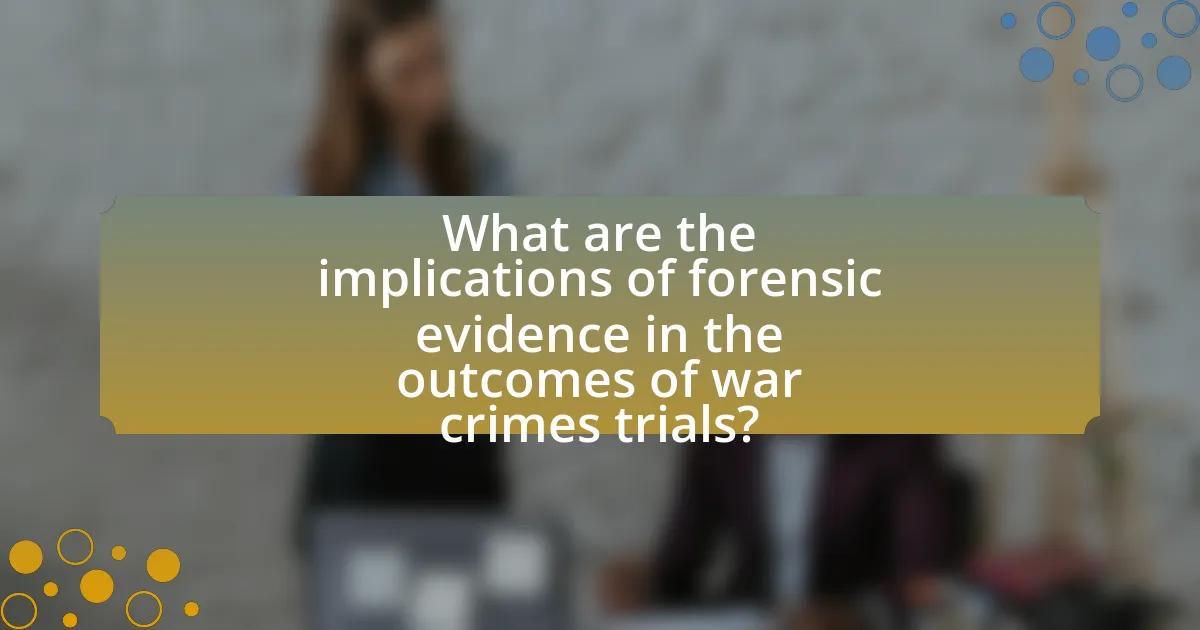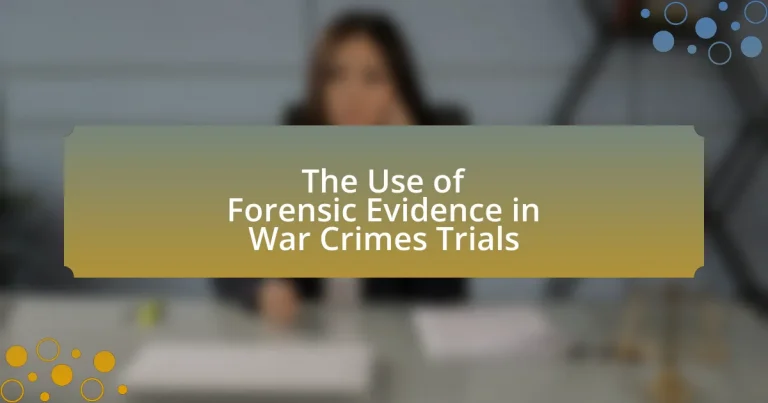Forensic evidence is a vital component in war crimes trials, providing scientific and objective data that supports claims of atrocities. This article examines the definition, types, and significance of forensic evidence, including DNA analysis, ballistics, and digital forensics, in establishing accountability and securing convictions. It also addresses the challenges and limitations faced in conflict zones, the role of international organizations in evidence collection, and best practices for presenting forensic evidence in court. Additionally, the article highlights the impact of forensic evidence on trial outcomes and the necessary training for professionals involved in war crimes investigations.

What is the role of forensic evidence in war crimes trials?
Forensic evidence plays a crucial role in war crimes trials by providing scientific and objective data that can substantiate claims of atrocities. This type of evidence includes physical remains, DNA analysis, and ballistic reports, which help establish the facts of the case, identify victims, and link perpetrators to specific crimes. For instance, the International Criminal Tribunal for the former Yugoslavia utilized forensic evidence to convict individuals for genocide and war crimes, demonstrating its effectiveness in securing justice. Such evidence not only aids in the prosecution but also serves to document historical events, ensuring accountability and supporting the rule of law in post-conflict societies.
How is forensic evidence defined in the context of war crimes?
Forensic evidence in the context of war crimes is defined as scientific data and material collected from crime scenes that can be used to establish facts in legal proceedings. This type of evidence includes physical remains, biological samples, and other trace evidence that can link individuals to specific acts of violence or atrocities. For instance, the International Criminal Court utilizes forensic evidence to corroborate testimonies and establish the occurrence of war crimes, as seen in cases involving mass graves where DNA analysis identifies victims and perpetrators.
What types of forensic evidence are commonly used in war crimes trials?
Forensic evidence commonly used in war crimes trials includes DNA analysis, ballistics, and forensic anthropology. DNA analysis helps identify victims and perpetrators through biological samples, while ballistics examines firearms and ammunition to link weapons to specific incidents. Forensic anthropology assists in the identification of human remains and can provide insights into the circumstances of deaths, such as mass graves. These types of evidence are crucial for establishing accountability and supporting legal proceedings in war crimes cases.
How does forensic evidence differ from other types of evidence in legal proceedings?
Forensic evidence differs from other types of evidence in legal proceedings primarily through its scientific basis and objective analysis. While traditional evidence, such as eyewitness testimony or circumstantial evidence, can be subjective and influenced by personal perceptions, forensic evidence relies on empirical data obtained through scientific methods, such as DNA analysis, ballistics, and toxicology. This scientific approach enhances the reliability and credibility of the evidence presented in court, as it is often subject to rigorous testing and validation processes. For instance, DNA evidence has a high degree of accuracy, with the probability of a random match being extremely low, thus providing strong support for its validity in legal contexts.
Why is forensic evidence crucial for war crimes prosecutions?
Forensic evidence is crucial for war crimes prosecutions because it provides objective, scientific data that can substantiate claims of criminal activity. This type of evidence, such as DNA analysis, ballistics, and digital forensics, helps establish the facts of a case, linking perpetrators to specific crimes and victims. For instance, the International Criminal Court has successfully used forensic evidence to convict individuals for genocide and crimes against humanity, demonstrating its effectiveness in securing justice. The reliability of forensic methods enhances the credibility of the prosecution’s case, making it more difficult for defense arguments to undermine the evidence presented.
What impact does forensic evidence have on the credibility of war crimes cases?
Forensic evidence significantly enhances the credibility of war crimes cases by providing objective, scientific validation of claims made during trials. This type of evidence, which includes DNA analysis, ballistics, and forensic anthropology, helps establish the facts surrounding incidents, such as identifying victims and perpetrators, and confirming the occurrence of specific events. For instance, the International Criminal Tribunal for the former Yugoslavia utilized forensic evidence to corroborate testimonies and establish the systematic nature of atrocities, leading to convictions based on solid scientific findings. Such evidence not only strengthens the legal arguments presented but also increases public trust in the judicial process by demonstrating a commitment to thorough and impartial investigations.
How does forensic evidence help establish the chain of command in war crimes?
Forensic evidence helps establish the chain of command in war crimes by providing tangible links between the actions of individuals and their superiors. This evidence can include documents, communications, and physical evidence that demonstrate orders given and actions taken. For instance, in the International Criminal Tribunal for the former Yugoslavia, forensic analysis of mass graves and the examination of military communications were crucial in linking commanders to specific war crimes, thereby illustrating their responsibility in the chain of command. Such forensic findings are essential for proving accountability and ensuring that those in leadership positions are held responsible for the actions carried out under their command.
What challenges are associated with the use of forensic evidence in war crimes trials?
The challenges associated with the use of forensic evidence in war crimes trials include issues of reliability, contamination, and the difficulty of obtaining evidence in conflict zones. Reliability is often questioned due to the potential for bias in evidence collection and analysis, as seen in cases where forensic experts may have affiliations with one side of the conflict. Contamination can occur during the chaotic environment of war, leading to compromised evidence integrity, which was highlighted in the International Criminal Tribunal for the former Yugoslavia, where evidence was sometimes collected under less-than-ideal conditions. Additionally, the difficulty of accessing crime scenes in active conflict areas can hinder the collection of crucial forensic evidence, as demonstrated in various trials where evidence was either lost or rendered inaccessible due to ongoing hostilities.
What are the limitations of forensic evidence in conflict zones?
Forensic evidence in conflict zones is limited by several factors, including compromised integrity, lack of access, and security risks. The chaotic environment of conflict zones often leads to contamination or destruction of evidence, making it unreliable. Additionally, ongoing violence can hinder forensic teams from accessing crime scenes, resulting in incomplete investigations. Furthermore, the presence of armed groups can pose significant security threats to forensic personnel, limiting their ability to collect and analyze evidence effectively. These limitations significantly impact the reliability and admissibility of forensic evidence in war crimes trials.
How do political and legal obstacles affect the collection of forensic evidence?
Political and legal obstacles significantly hinder the collection of forensic evidence by imposing restrictions on access to crime scenes and limiting the authority of investigators. For instance, in conflict zones, governments may deny access to international forensic teams due to sovereignty concerns or political agendas, which directly impacts the ability to gather crucial evidence. Additionally, legal frameworks may not support the use of certain forensic techniques, or there may be a lack of cooperation between jurisdictions, further complicating evidence collection. Historical examples include the challenges faced by the International Criminal Tribunal for the former Yugoslavia, where political interference often delayed investigations and evidence gathering, illustrating how such obstacles can impede justice in war crimes trials.

How is forensic evidence collected and analyzed in war crimes cases?
Forensic evidence in war crimes cases is collected through systematic procedures that include securing the crime scene, documenting evidence, and gathering physical samples. Investigators utilize techniques such as photography, sketching, and note-taking to ensure accurate representation of the scene, while also collecting biological, chemical, and ballistic evidence for analysis.
The analysis of this evidence is conducted in specialized laboratories where forensic scientists employ methods like DNA profiling, toxicology tests, and ballistics analysis to establish connections between suspects and the crimes. For instance, DNA evidence can link a perpetrator to a victim or a crime scene, while ballistic analysis can match bullets to specific firearms used in the commission of war crimes.
The validity of these methods is supported by established forensic protocols and standards, such as those outlined by the International Criminal Court and various forensic science organizations, ensuring that the evidence collected is reliable and admissible in court.
What procedures are followed for collecting forensic evidence in war zones?
In war zones, the procedures for collecting forensic evidence involve systematic approaches to ensure the integrity and reliability of the evidence. These procedures typically include securing the scene, documenting the environment, collecting physical evidence, and maintaining a chain of custody.
Securing the scene involves establishing a perimeter to prevent contamination and unauthorized access. Documentation includes photographing and sketching the scene, noting the position of evidence, and recording environmental conditions. Collecting physical evidence entails gathering items such as weapons, ammunition, and biological samples, which are then properly packaged to avoid degradation. Maintaining a chain of custody is crucial; it ensures that all evidence is tracked from the moment of collection through to its presentation in court, thereby preserving its integrity for legal proceedings.
These procedures are critical in war crimes trials, as they provide the necessary foundation for establishing accountability and justice.
What role do international organizations play in evidence collection?
International organizations play a crucial role in evidence collection by establishing protocols, providing resources, and facilitating cooperation among states and non-state actors. These organizations, such as the United Nations and the International Criminal Court, often deploy expert teams to conflict zones to gather forensic evidence, document human rights violations, and ensure that evidence is collected in a manner that is admissible in court. For instance, the United Nations has conducted numerous investigations into war crimes, employing forensic experts to analyze mass graves and other crime scenes, thereby contributing to the accountability of perpetrators. This systematic approach to evidence collection enhances the integrity of war crimes trials and supports the pursuit of justice on an international scale.
How is the integrity of forensic evidence maintained during collection?
The integrity of forensic evidence is maintained during collection through strict adherence to established protocols and chain of custody procedures. These protocols ensure that evidence is collected, documented, and preserved in a manner that prevents contamination or alteration. For instance, forensic professionals utilize specialized tools and techniques to collect samples, such as using gloves and sterile containers, which minimizes the risk of introducing foreign substances. Additionally, maintaining a clear chain of custody, where each individual who handles the evidence is documented, reinforces accountability and traceability, thereby safeguarding the evidence’s integrity throughout the investigative process.
What techniques are used to analyze forensic evidence in war crimes trials?
Techniques used to analyze forensic evidence in war crimes trials include DNA analysis, ballistics examination, and digital forensics. DNA analysis helps identify victims and perpetrators through biological samples, while ballistics examination links firearms to specific incidents by analyzing bullet trajectories and cartridge casings. Digital forensics involves recovering and analyzing electronic data, such as communications and documents, to establish timelines and connections between individuals involved in war crimes. These techniques are critical in providing objective evidence that can support legal proceedings and establish accountability for war crimes.
How do forensic scientists ensure accuracy in their analyses?
Forensic scientists ensure accuracy in their analyses through rigorous methodologies, standardized protocols, and continuous training. They utilize validated techniques such as DNA profiling, fingerprint analysis, and toxicology testing, which have been extensively peer-reviewed and accepted within the scientific community. Additionally, forensic laboratories adhere to quality assurance standards set by organizations like the American Society of Crime Laboratory Directors, which mandates regular audits and proficiency testing to maintain high accuracy levels. These practices collectively contribute to the reliability of forensic evidence presented in war crimes trials, ensuring that findings are both scientifically sound and legally defensible.
What technologies are employed in the analysis of forensic evidence?
Technologies employed in the analysis of forensic evidence include DNA analysis, digital forensics, and chemical analysis. DNA analysis utilizes techniques such as polymerase chain reaction (PCR) and short tandem repeat (STR) profiling to identify individuals based on genetic material. Digital forensics involves the recovery and investigation of material found in digital devices, employing tools like EnCase and FTK to analyze data and recover deleted files. Chemical analysis, including mass spectrometry and gas chromatography, is used to identify substances and residues, providing crucial evidence in forensic investigations. These technologies are essential in establishing connections between suspects and crime scenes, thereby supporting legal proceedings in war crimes trials.

What are the implications of forensic evidence in the outcomes of war crimes trials?
Forensic evidence significantly influences the outcomes of war crimes trials by providing objective, scientific validation of claims made during the proceedings. This type of evidence, which includes DNA analysis, ballistics, and digital forensics, can establish the identity of victims and perpetrators, corroborate witness testimonies, and reconstruct events. For instance, the International Criminal Tribunal for the former Yugoslavia utilized forensic evidence to convict individuals for genocide and war crimes, demonstrating its critical role in securing justice. The presence of reliable forensic evidence often strengthens the prosecution’s case, leading to higher conviction rates and more comprehensive accountability for war crimes.
How does forensic evidence influence jury decisions in war crimes cases?
Forensic evidence significantly influences jury decisions in war crimes cases by providing objective, scientific data that can corroborate testimonies and establish facts. This type of evidence, such as DNA analysis, ballistics, and digital forensics, helps juries assess the credibility of claims made by both the prosecution and defense. For instance, in the International Criminal Tribunal for the former Yugoslavia, forensic evidence was crucial in establishing the identities of victims and the circumstances of their deaths, which directly impacted jury perceptions and verdicts. The reliability and clarity of forensic evidence often lead juries to favor conclusions supported by tangible proof over subjective accounts, thereby shaping the outcomes of these complex legal proceedings.
What case studies illustrate the impact of forensic evidence on trial outcomes?
Case studies that illustrate the impact of forensic evidence on trial outcomes include the International Criminal Tribunal for the former Yugoslavia (ICTY) cases, particularly the trial of Radovan Karadžić. In this case, forensic evidence, including DNA analysis and mass grave excavations, played a crucial role in establishing the systematic nature of war crimes and genocide committed during the Bosnian War. The tribunal relied on forensic findings to corroborate witness testimonies and to link the accused to specific crimes, ultimately leading to a conviction and a 40-year prison sentence.
Another significant case is the trial of Charles Taylor at the Special Court for Sierra Leone, where forensic evidence, including the analysis of weapons and the examination of mass graves, was pivotal in demonstrating his responsibility for war crimes and crimes against humanity. The court’s reliance on forensic evidence helped to substantiate the claims of victims and witnesses, contributing to Taylor’s conviction and a 50-year prison sentence.
These examples underscore how forensic evidence can decisively influence trial outcomes by providing concrete, scientific validation of allegations in war crimes trials.
How do judges interpret forensic evidence in their rulings?
Judges interpret forensic evidence in their rulings by evaluating its relevance, reliability, and the scientific validity of the methods used to obtain it. They assess whether the forensic evidence meets legal standards, such as the Daubert standard in the United States, which requires that scientific testimony be based on sufficient facts or data and be the product of reliable principles and methods. Additionally, judges consider the context in which the evidence was collected and how it supports or contradicts other evidence presented in the case. This careful scrutiny ensures that the forensic evidence contributes meaningfully to the determination of guilt or innocence in war crimes trials.
What are the best practices for utilizing forensic evidence in war crimes trials?
The best practices for utilizing forensic evidence in war crimes trials include ensuring proper collection, preservation, and analysis of evidence, as well as maintaining a chain of custody. Proper collection involves using standardized protocols to gather evidence without contamination, which is critical for its admissibility in court. Preservation requires storing evidence in controlled conditions to prevent degradation, while analysis should be conducted by accredited forensic experts using validated methods to ensure reliability. Maintaining a chain of custody is essential to document the handling of evidence from the crime scene to the courtroom, thereby establishing its integrity. These practices are supported by guidelines from organizations such as the International Criminal Court, which emphasizes the importance of forensic evidence in establishing accountability for war crimes.
How can legal teams effectively present forensic evidence in court?
Legal teams can effectively present forensic evidence in court by ensuring that the evidence is clearly explained, properly authenticated, and relevant to the case. Clear explanations involve breaking down complex forensic concepts into understandable terms for the judge and jury, which enhances comprehension. Proper authentication requires demonstrating the chain of custody and the reliability of the forensic methods used, as established in cases like Daubert v. Merrell Dow Pharmaceuticals, which set standards for admissibility of expert testimony. Relevance is established by directly linking the forensic evidence to the specific allegations in the war crimes trial, thereby reinforcing its significance in the context of the case.
What training is necessary for professionals involved in war crimes investigations?
Professionals involved in war crimes investigations require specialized training in forensic science, legal frameworks, and human rights law. This training equips them with the skills to collect, preserve, and analyze evidence in compliance with international standards. For instance, courses in forensic anthropology and pathology are essential for understanding the physical evidence of war crimes, while training in international humanitarian law ensures that investigators are aware of the legal implications of their findings. Additionally, practical experience in conflict zones is crucial for developing the necessary field skills and understanding the complexities of such environments.


